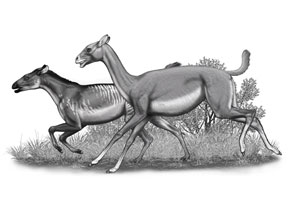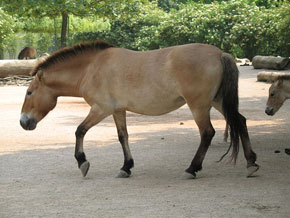Equidae
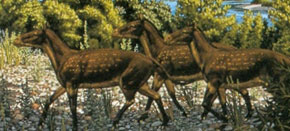 Pictured left: Reconstruction of extinct grazing horse Mesohippus. Rob Barber\AMNH.
Pictured left: Reconstruction of extinct grazing horse Mesohippus. Rob Barber\AMNH.
Equidae: the true horses of the family, Equidae first appeared in North America at the beginning of the Eocene, about 55.5 MYA. Only a few minor details of the skull and teeth unite horses into a single family; the features that we normally think of as equine, such as high-crowned hypsodont teeth, large size, long limbs, and single-toed feet, actually evolved gradually within the Equidae and were not present in the earliest members of the group.
Although various types of horses eventually migrated to other continents, the center stage for horse evolution was North America. Horses became extremely common on the continent at various times during the Cenozoic. The first equids, such as Protorohippus and Xenicohippus, were very abundant in the early Eocene of North America, but became rarer in the middle Eocene. Mesohippus is a small horse that was common in the late Eocene and Oligocene. It was small, retained three toes, and had evolved teeth that were better adapted for shearing leaves.
In the Miocene, there was an explosion of horse diversity in North America. One reason for this is that both browsing and the grazing horses were present for much of this period. Browsing horses, with skeletons and dentitions very similar to those of Mesohippus, continued to survive in North America; some of them, such as Megahippus, achieved body sizes similar to modern draft horses.
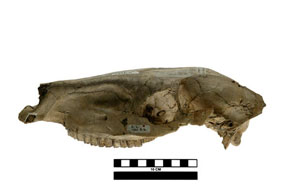
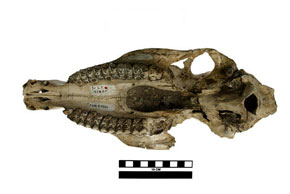
Left: Skull of the early grazing horse Merychippusinsignis (AMNH 87001) from Sioux Country, Nebraska. Victoria Healy\AMNH. Right: Ventral view of the skull of the early grazing horse Merychippus (AMNH 87001) from Sioux Country, Nebraska. Victoria Healy\AMNH.
Then, about 18 MYA, a new type of horse, named Merychippus, appeared alongside the browsers. Merychippus was the first horse to begin to show similar characters to modern horses. Its side toes were significantly reduced in size; it had longer and more slender limbs than the browsing horses; and its molars were taller and had a more complex surface pattern. Merychippus was the first horse adapted to feeding and living in the open grasslands that were spreading across the continent at that time. By the middle Miocene, many descendents of Merychippus roamed North America and it is not unusual to find up to 12 species at a single fossil site, indicating that many species lived together in the same habitats. These horses had different body sizes and probably had different diets and behavioral patterns which allowed them to coexist.
By 9 MYA, the browsing horses were all extinct. Many other horse species went extinct by the end of the Miocene, although the living genus, Equus, persisted through to the end of the last ice age. It is an interesting fact that although horses underwent most of their evolution in North America, they went ultimately went extinct there. Horses in North American today, even wild horses, are descendents of domestic horses brought in ships from Europe!
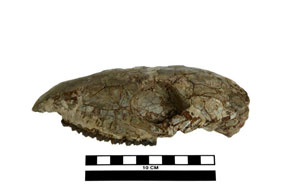
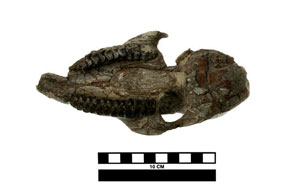
Left: Skull of the early horse Mesohippus (AMNH 39004)from Pennington County, South Dakota. Note the low-crowned molars typical of this browsing species. Victoria Healy\AMNH. Right: Ventral view of the skull of the early horse Mesohippus (AMNH 39004)showing molar surfaces. Victoria Healy\AMNH.
North America was dominated by horses in the Miocene. Just how abundant were horses during this time? One measure is that there is an entire floor of the Childs Frick Building at the American Museum of Natural History, over 5,000 square feet in area, that contains only horse fossils; the vast majority of these are from Miocene rocks. There are an estimated 50,000 fossil horses in the AMNH collection and it is safe to say that no other Family of mammal is so abundant to have an entire floor of fossils in a museum collection!

